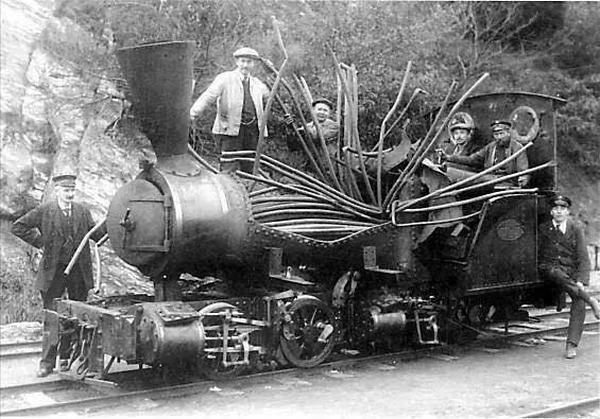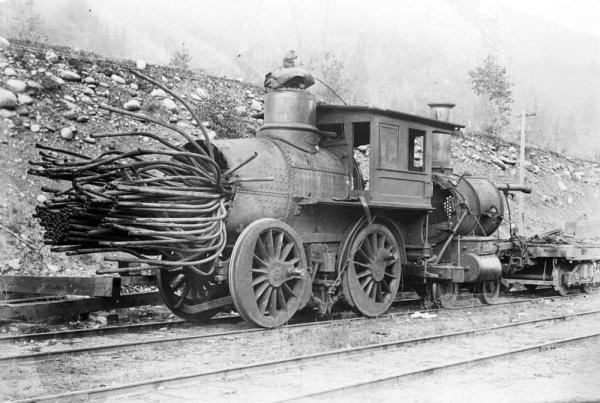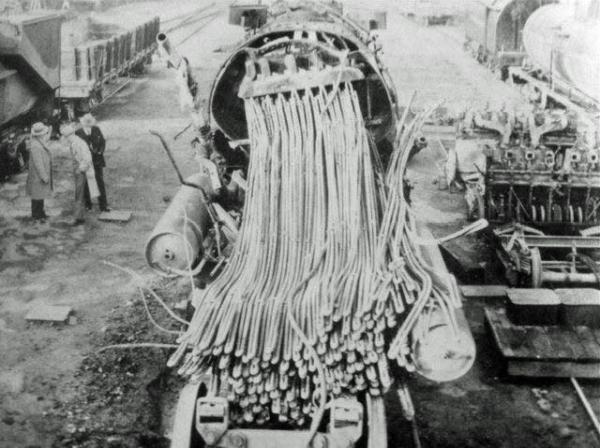[Warning: Accidents and Horrible Death, not graphic]
After I’ve watched a bunch of videos on youtube of Russian tanks getting variously blown up and shot at, the algorithm appears to have decided I’m a nasty person and has started feeding me all kinds of things that blown up, crashed, and otherwise disastrously killed passengers. This one really caught my eye.

See what I mean? For a few seconds I was thinking maybe a train had run through a crop of rebar or something like that. But then I figured it out and watched the explainer. Spoiler: it did not go well for the operators in the locomotive cab.
It explains a bit about how these accidents came to pass; that’s interesting. Apparently boilers had a “superheater” where the steam that was about to go to the engine would make a pass through a coil that was basically exposed to naked flame, just to kick its energy up a notch before going to the drive. That could be problematic if the pressure dropped, because then the superheater pipe might melt.

While we complain appropriately about the bad side-effects of internal combustion engines running on oil or natural gas, it’s easy to forget that they were a huge improvement over having to shovel fuel into a fire-box while simultaneously trying to operate a rolling steam-bomb.
In fact, it was a fairly common failure mode. Common enough that there are lots of pictures of blown boilers, but uncommon enough that it was newsworthy when it happened.

[Security expert Bruce Schneier uses the “newsworthiness” of an incident as a fairly useful metric for thinking about terrorism: stuff that happens rarely is newsworthy but if it happens all the time it’s “another monday.”]
Look at the way the train’s wheels are driven into the ground by the force of the escaping, uh, engine’s upper half. I’m pretty uncomfortable at the sight of steel pipe that appears to have taken on the form of a noodle, however briefly.

Look at the expression on the faces of the guys in the drivers’ seats. They are clearly fans of steam power. Actually, I wonder if the lingering scent of the former drivers was bothering them.
Where the lip of the torn back boiler is exposed, you can see it’s 1/4″ steel (or thereabouts) and it’s triple-riveted. Yet, it still launched.

In the picture above, it appears that the front of the engine has blown off and been placed on the track behind the back of the engine. That’s why it looks a bit odd. Did this happen so often that there were people with experience in wrangling blown steam locomotives?

Steam was used in factories, as well, though where possible the power-plant was separated from the work-hall and rotational drives were used to carry impulse. I always thought that was pretty dangerous (the big overhead spinning pulleys and belts) but I guess it’s preferable to having a steam engine in the room. The photo above is of a steam locomotive inside a factory building; it was probably picking up a load of something and sat idling too long while the steam was up.

I suspect some of you have also watched the amazing Quinn Dunki’s series on making her own steam engines. I love her lucid and honest explanations of machining problems she overcomes. I also, now, have a lot more guarded respect for someone who works with steam instead of, you know, nice safe clean propane and oxygen like I do.

Those images are reminiscent of the TV portrayal of Chernobyl, the lid blowing off all at once without warning. (See also: Mythbusters.)
Yes, safe, clean propane. I read this item about a 2013 death in Australia recently. A man’s LPG tanks were leaking, turning his moving truck into a time bomb.
Damn liberal media always obscures the real tragedy: In every one of these cases, investors lost money!
90 years previously, steamboats blew up regularly on the Mississippi. Mark Twain lost his younger brother to such an explosion.
Oh hell yes!
Steam engines were disasters waiting to happen. In fact, some historians have claimed that the disaster of the SS Sultana might have destroyed Abraham Lincoln’s second term, if he hadn’t been assassinated.
I’ve always been fascinated by failure.
This is RIGHT in my wheelhouse.
One notable thing about these pictures: they’re old. There’s a huge body of knowledge coming out of these accidents, that leads to international standards and codes for the manufacture of pressure vessels and steam systems, standards I refer to most weeks in the course of my profession. Building vessels that will contain the pressure, and designing and sizing valves that will reliably relieve that pressure when required, is a whole area of work itself, and hugely important to most manufacturing industry at some point.
Still happens, a lot. The place I worked the longest made PTFE. The raw material, chlorodifluormethane, was turned into the monomer, TFE, by steam pyrolysis – that is, contacting it with steam which, although it was only at about 3bar gauge pressure (and thus "normally" only at 143C), was superheated in exactly this way to 950C, or for those of you outside the civilised world, over 1700F. The pipes glow in normal operation. Fun times.
I went to school less than a mile from the largest working example of this in the world. https://en.wikipedia.org/wiki/Trencherfield_Mill . If you’re ever in northwest England, it’s worth a visit if you’re into that sort of thing. It now only runs on Sundays, but in the eighties when I was at school it ran most days – you could hear the whistle clear across town, to which my Scouse further mathematics teacher would invariably respond “dem boats come close don’t dee?”.
Oh, and one other piece of info: in the job before that, I engineered a plant processing cocoa beans for a global chocolate firm. Pretty much the first thing that happened to the beans, after they’d had the sand, rocks, needles, Ghanaian coins and other debris separated out, and before they were roasted, was that they’d be blasted with superheated steam to kill any nasty bugs on them.
Superheated steam is great stuff – really safe, because if you stick to the vessel design codes, the only place it gets out is pinholes and gasket failures, and such leaks (a) are loud (b) are very easy to spot and stay away from (c) happen progressively rather than suddenly, and (d) when the steam gets out it has no tendency to go looking for an ignition source so that it can explode and demolish your factory killing everyone inside, unlike, e.g. cyclohexane #Flixborough.
sonofrojblake@#6:
The raw material, chlorodifluormethane, was turned into the monomer, TFE, by steam pyrolysis – that is, contacting it with steam which, although it was only at about 3bar gauge pressure (and thus “normally” only at 143C), was superheated in exactly this way to 950C, or for those of you outside the civilised world, over 1700F. The pipes glow in normal operation. Fun times.
That sounds really interesting. Is the steam used because it’s possible to precisely control the temperature?
I remember one old video I saw of them tempering blades at a razor factory, by dunking them in molten lead. It gives a very good and predictable contact, and it’s only molten at a certain temperature or higher. The current “hot thing” for tempering is molten salt.
sonofrojblake@6: Great comment.
Especially in the older pictures, things like uneven material quality and slag inclusions in the steel would probably have played a role as well.
But even today with modern design rules and material, a simple domestic water heater may turn into a rocket when mishandled. See the infamous Mythbusters videos.
As sonofrojblake said: There is a reason that steam boilers are supposed to be inspected regularly in civilized countries and you need a certification to operate them.
Among the hazardous things in pulp mills, the biggest and most expensive is the recovery boiler. Not only is it a steam boiler heated with black liquor (basically the lignin from the pulped wood dissolved in a water solution of sodium and sulfur salts and lye, about 80 % dry matter), but there are molten salts (a mixture of sodium carbonate and sodium sulfide) on the bottom, which are tapped in a controlled way into water in order to recover the pulping chemicals (the resulting green liquor is filtered and causticised with burnt lime and filtered again, resulting in the pulping chemical white liquor, which is actually reddish yellow).
If the molten salts get into contact with water in an uncontrolled way, a huge explosion will occur. The density of liquid water is (depending on temperature) over 2000 times as great as the density of steam in 1 atmosphere.
The Electric Vehicle Revolution Is Coming for Trains
IIRC, the insurance industry had much to do with improving steam engine safety. Did legal safety standards play catch up or in some cases lead?
Partly. Put very crudely, the H20 also mops up byproducts.
“The” pyrolysis reaction in question is CHClF2 –> :CF2 + HCl and then immediately 2 :CF2 —> C2F4 . (The subscript HTML tag doesn’t seem to work, sorry).
In reality even in the best controlled process there are a LOT of other things going on, things that produce other substances that are no good to you, including but not limited to perfluoroisobutene. You need to separate this (and all the other stuff, including other fun stuff like HF) out by distillation, and periodically you have to prove to the UN weapons inspectors that you’re destroying it, because literally one breath of the stuff is lethal. I don’t think it’s the most lethal stuff I’ve ever worked with, but the combination of how little it takes to kill you and how quickly after exposure you’re gone is hard to beat.